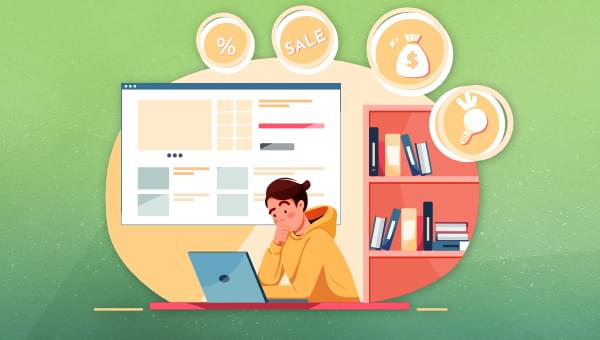In this article, we’ll look at the must-have ecommerce design elements that can make your ecommerce business soar. How a few tweaks to your online store’s appearance can lead to more satisfied customers and, of course, better sales.
Have you ever wondered what sets a thriving and successful ecommerce business apart from the rest? What makes the best ecommerce websites or the best ecommerce stores so much better?
As a designer working at a UX Design studio, I’ve frequently encountered many ecommerce businesses making the same mistakes. It’s not just about having great products; it’s also about creating an incredible shopping experience, and that’s where ecommerce design elements come into play.
Consistency is Key
In ecommerce website/store design, there are some common pain points that make the whole shopping experience seem a bit unprofessional. Often, something just doesn’t feel right: maybe the brand colors are all over the place, or buttons seem to change shape with every click.
To make your online store a welcoming place for visitors, keep things consistent. Use the same colors, fonts, buttons, and icons throughout your site. It may seem like a small detail, but it goes a long way in making your ecommerce store look polished and trustworthy.
Secure Financial Transactions
First and foremost, when it comes to ecommerce website/store design, one of the cornerstones of success lies in providing secure payment options.
Imagine shopping in a physical store where you’re not sure whether your payment information is safe. It’s a scenario that would deter most shoppers, and the same holds true in the online world.
Secure payments are super essential not only because they safeguard customer data, but also because they enhance the overall user experience.
Secure payment gateways
To begin with, integrating reputable payment gateways is crucial. They ensure that only legitimate transactions go through the door. Names like PayPal, Stripe, and Authorize.net probably ring a bell. These gateways are renowned for their top-notch security measures.
These security measures, such as encryption and fraud protection, not only protects the customer’s data but also instill confidence in them. When they see these names at the checkout page, they know their payment information is in safe hands.
Encrypted transactions and fraud protection are the unsung heroes that keep those credit card details locked away from prying eyes and contribute to a positive UX and trust rating.

SSL certificates
Speaking of security, let’s talk about SSL certificates. They’re there to ensure that the data transmitted between your ecommerce business and your customers is encrypted.
These certificates turn your ecommerce website into a fortress. When your customers visit your site and see that little padlock icon in their browser’s address bar, it’s like a warm, reassuring handshake.
It’s like sending secret messages that only the intended recipient can decipher. This encryption is a must for securing payment details and customer information.
This visual cue not only boosts trust but also removes the most basic concerns regarding data security.
Trust seals and badges
Remember those “Norton Secured” or “McAfee Secured” badges you see on websites? These trust seals are like gold stars on your ecommerce report card. They show that your ecommerce website is scanned regularly for vulnerabilities and is free from any type of malware.
When customers see these badges, they feel more confident about shopping with you. It’s like a virtual handshake with a security expert. They know you’ve taken the necessary steps to protect their sensitive information.
In a nutshell, having these elements in place not only safeguards your customer’s data but also boosts their trust in your brand. So, when you’re designing your ecommerce website, make sure to prioritize these trustworthy and secure payment options. Your customers will thank you for it, and your business will reap the rewards.
Positive brand perception
Lastly, secure payment options impact how the customers perceive your brand. When your ecommerce site prioritizes security, customers associate your brand with trustworthiness.
This positive perception fosters a long-term customer loyalty which encourages customers to return for future purchases and might even go out of their way to order from your ecommerce website.
In conclusion, secure payment options directly influence the customer’s user experience by building their trust, reducing cart abandonment, and shaping positive brand perception.
User-friendly Navigation
In the realm of digital shopping world, user-friendly navigation is a linchpin for success. You know how, in a physical store, finding your way around is crucial to having a great shopping experience. The same holds true for shopping in the online world.
Clear navigation menus
When you’re walking into a store with aisles that are clearly marked and where products are neatly organized, it becomes a breeze to find what you need. Your ecommerce website should offer the same convenience.
Clear navigation menus are like the road signs in your ecommerce website. They guide your customers to their desired products or sections with ease. Categories like “Women’s Apparel”, “Electronics”, and “Home Decor” should be prominently visible.
This straightforward presentation ensures that users can quickly find what they’re looking for, thus minimizing frustration and making the customer journey a walk in the park.
Search functionality
Effective search options are super important for any ecommerce website. Customers can simply type in what they want, and voilà, the results appear. A well-designed search bar not only saves time but also reduces frustration. It’s like having a friendly shop assistant who knows where everything is and guides you.

Make sure that your search bar is not only prominent but also capable of understanding various search terms to show results that are as accurate to customer’s wants as they can be.

Lowering bounce rates
User-friendly navigation serves not only as a guide but also as a means to retain visitors. High bounce rates, characterized by visitors swiftly leaving your ecommerce website shortly after arriving, can often be traced back to perplexing or frustrating navigation.
Providing users with a clear and intuitive path throughout your ecommerce website can effectively keep them engaged.
Consequently, this approach reduces bounce rates and enables you to refine your conversion strategy for your ecommerce platform.
Compelling Product Imagery and Descriptions
Crafting compelling product imagery and descriptions is akin to setting up an enticing shop window when it comes to ecommerce site design. It’s like giving your ecommerce store visitors a front-row seat to your offerings.
A picture is worth a thousand clicks

Imagine walking into a store where the lights are dim, making it really hard to see the products properly. Frustrating, right? The same applies to your ecommerce platform. Your product images should be clear, crisp, and high-resolution.
High quality photos are the visual anchors of your ecommerce store and the closest thing to customers physically interacting with your product.
When customers can see, examine each and every individual stitch, every nuanced feature, and the whole spectrum of color variation, they’re more likely to make a confident purchase. And that’s bound to drive in more sales for you and your business.
Answering the whats, hows, and whys
While images can speak volumes, its the product descriptions that are the storyteller of your ecommerce website.
Your customers can’t touch or feel your products online, so it becomes your job to paint a vivid picture with words for the target audience. A detailed product description does just that.
Think about what questions your customers might have. What’s the product made of? How does it work? Why should they choose it over similar options? What are its unique features? Your product description should provide answers to these questions.
When customers find all the information they need, they feel informed and confident, just like they would if they were in a physical store with a helpful salesperson.
User-generated content
Have you ever bought something online and checked the reviews first? If so, you’re not alone!
According to a study, around 95% of customers read online reviews before buying a product. This makes social proof like customer reviews and ratings a goldmine for building trust.
When customers see that others have had a positive experience with your products, they’re more likely to trust your brand. Your design should encourage visitors to leave reviews and ratings which acts as a positive social proof for newer customers. It’s like word-of-mouth marketing in the digital age.
Remember, when you pair high-quality images with detailed descriptions and user-generated content, you’re creating a shopping experience that’s almost as good as being in a physical store. When customers can see, understand, and trust your products, it can lead to higher conversion rates and happier shoppers.
It’s all about helping the shopper see, understand, and trust the products they’re interested in. That’s what leads to happier online and more successful online shopping adventures!
Visual storytelling
Beyond individual product images, consider how these images tell a cohesive visual story about your brand. Consistency in photography style and branding element can help customers recognize and trust your brand, while reinforcing your brand identity in the process.
Streamlined Checkout Process
We’ve covered some exciting ground so far, and now it’s time to tackle a topic that can make or break a sale: the streamlined checkout process. It’s like the express lane at a grocery store, but for your online shoppers. Let’s jump right in.
Guest checkout convenience
Have you ever found yourself in a rush at a physical store, wishing you could simply pay for your items and leave without being pressured to sign up for a loyalty card? Well, your online shoppers often share the same sentiment. This is where the guest checkout feature truly shines on your ecommerce website.
Guest checkout offers customers the convenience of making a purchase without the inconvenience of mandatory account creation. It’s like granting them a “skip the registration line” pass, ensuring a streamlined shopping experience.
By incorporating guest checkout into your ecommerce website, you not only expedite the purchase process but also empower customers to quickly acquire what they desire, potentially boosting your conversion rates.
Progress indicators

When there are no signs to tell you where you’re going, you get frustrated. The same goes for a confusing checkout process. Your customers should know exactly where they are in the purchase journey.
Progress indicators do just that. They show customers where they are, what steps they’ve completed, and what’s left to do. This transparency reduces anxiety and uncertainty.
When shoppers can see that they’re progressing toward completing their purchase, they’re more likely to stay engaged and complete the transaction.
Multiple payment options
Just as some people prefer cash while others opt for credit cards, your customers have different payment preferences. To make everyone feel welcome, you should offer multiple payment options.
Credit cards, debit cards, digital wallets like PayPal, and even alternative payment methods like Buy Now, Pay Later should ideally be on the menu. This flexibility ensures that you’re not turning away potential customers due to payment constraints.
By offering guest checkout, progress indicators, and a variety of payment options, you’re smoothing the path to purchase. Your online store becomes a hassle-free destination where customers can shop with ease and confidence.
Brand perception
Beyond the transaction itself, a smooth and hassle-free checkout in online stores leaves a lasting impression on your customers.
When the checkout is effortless and secure, it leaves a positive perception of your brand, building trust and loyalty in the process.
With a streamlined checkout process, you’re not just making sales; you’re creating happy and satisfied customers.
As you design or optimize your ecommerce website/store, remember that a user-friendly checkout is a fundamental element in delivering exceptional user experience.
Mobile Responsiveness
Mobile browsing and shopping via mobile devices has become more prevalent than ever. Is your ecommerce website mobile-friendly? If not, you might be overlooking a substantial portion of potential customers.
Mobile responsiveness entails that your ecommerce design seamlessly adapts to various screen sizes. Whether your customers access your website from a desktop, tablet, or mobile phone, they should enjoy a smooth and hassle-free shopping experience.
Keep in mind that a frustrating mobile experience can result in shopping cart abandonment and potential sales slipping through the cracks.
Accelerated loading times
In the realm of ecommerce design, the need for faster loading times is indisputable, particularly when it comes to mobile devices. This agility holds pivotal importance in captivating and retaining the attention of mobile users.
With the prevalence of smartphones and the ever-increasing trend of on-the-go browsing, every passing moment is significant. An ecommerce website equipped with seamless adaptability ensures that customers stay engaged, preventing the risk of them losing interest due to sluggish loading times.
It’s worth emphasizing that a slow-loading website can result in a high bounce rate, adversely affecting both the user experience and overall sales.
Touch-friendly interfaces
Mobile users interact with their devices using different touch gestures or hand gestures, such as tapping, swiping and pinching.
A well-designed, responsive mobile website incorporates touch-friendly elements, ensuring that everything is appropriately sized and spaced for easy interaction.
Google’s embrace of mobile-first indexing
From an SEO perspective, mobile responsiveness holds immense significance for ecommerce websites. Google has wholeheartedly embraced a mobile-first indexing strategy, wherein it primarily assesses a site’s mobile version to determine its ranking.
In essence, mobile responsiveness extends beyond catering to mobile users; it’s about fostering a user-centric design that seamlessly adapts to their preferences and requirements.
In an era marked by the surging popularity of online mobile shopping, making this a priority in your ecommerce design can significantly bolster your website’s performance.
Conclusion
In this article, we’ve guided you through the key elements that can transform your online store into a shopper’s paradise.
It’s clear that the digital storefront is not just about aesthetics. These ecommerce design elements are the building blocks that can shape your online store into a place where users not only shop but also enjoy and trust.
Before we wrap things up, let’s reinforce the importance of these design elements.
Enhancing UX for lasting impact
Throughout this blog post, we’ve seen how each design element plays a role in enhancing the user experience. By ensuring that the customers can effortlessly browse, shop and transact, it can create an exceptional user experience.
This kind of UX is not just nice to have; it also becomes the cornerstone of customer satisfaction and loyalty.
These design elements are like the ingredients in a secret recipe for ecommerce success. When combined, they create a website that’s not just functional but also captivating and trustworthy.
Continuous adaptation
Ecommerce website/store design is a dynamic field that evolves alongside technology. Keeping up with these changes and being in tune with your audience is essential.
Be open to experiments, keep collecting user feedback and embrace new design trends. It will help you keep your ecommerce website/store relevant and user centric.
Moving beyond transactional ecommerce designs
It’s really important to understand that ecommerce design encompasses more than just transactional interactions. Equally significant is the creation of a brand experience that leaves a lasting impression of trust and memorability among users.
Content and satisfied customers are more likely not only to return for future purchases but also to refer friends and become devoted brand advocates. Your design serves as the cornerstone in establishing a meaningful and enduring relationship between your ecommerce website and your valued customers.
Ecommerce website design isn’t a one-time endeavor. Rather, it’s a continuous and evolving process that requires your unwavering attention, creative input, and dedication.
As you immerse yourself in the world of ecommerce design, keep in mind that your journey is only commencing. Embrace this ever-evolving landscape, harness these design elements to your advantage, and ensure the spirit of innovation remains alive and well.
 Yash Bhatt
Yash BhattYash is a UX designer at Tcules with a fervor for crafting digital experiences that truly resonate with users. His heart belongs not only to UX design but also to the thrilling world of football and the enchanting universe of anime.


